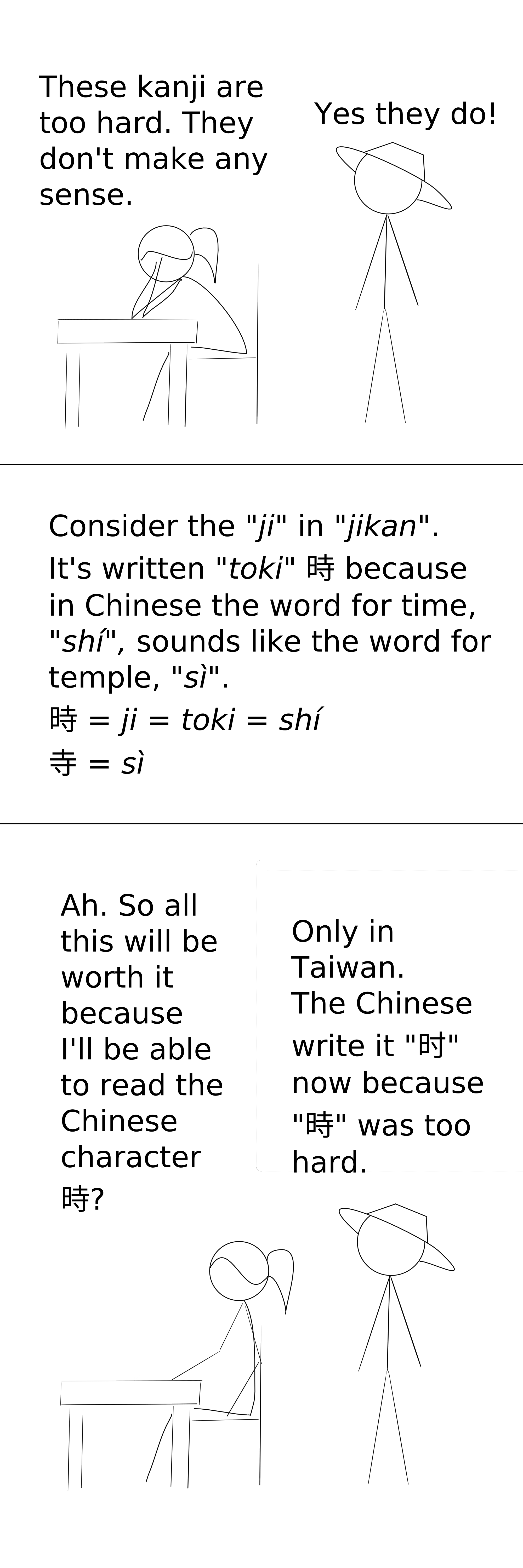The United States Department of Defense classifies languages according to how hard they are for English-speakers to learn.
Category IV is for languages with something unusually difficult about them. For example, Chinese is Category IV because of Chinese characters (漢字).
Japanese is a Category IV language too. Japanese uses fewer 漢字 than Chinese does, but those it does use often don't make any sense (in Japanese) because approximately half of 漢字 are based off of Chinese puns. Chinese and Japanese belong to different language families.
Languages often distinguish homonyms via slightly different spellings. In Chinese, "character" is pronounced "zì" and "child" is pronounced "zǐ". Thus, "character" is written "字" and child is written "子".
In Japanese, "character" is pronounced "ji" and "child" is pronounced "ko". Japanese often uses Chinese characters. Thus, "character" is written "字" and child is written "子"—even though their pronounciations are nothing alike.

It gets worse. In Chinese, "中" is always pronounced "zhōng" because 漢字 were designed according to Chinese etymology. In Japanese, "中" is sometimes pronounced "naka" and is sometimes pronounced "chū" because because 漢字 were designed according to Chinese etymology.
If your first experience of 漢字 comes from Japan without the Chinese context then 漢字 would seem like the craziest writing system on Earth. But if you come from East Asia then it makes sense.
The purpose of writing is to be understood. If you were a scholar inventing writing in ancient Japan then you would want your writing system to be as easy as possible for your target audience to read.
There are several mutually unintelligable spoken Chinese languages (such as Mandarin, Cantonese, Gan, Min and Yue). Spoken Chinese is a family of languages but written Chinese is a single language. Your target audience is fellow scholars, all of whom can read Chinese. Chinese is already used to write every language you and your audience have ever read.
Unfortunately, there are Japanese words (especially grammatical particles and verb suffixes) which have no Chinese equivalent. For these words, you'll need a pheonetic writing system. You list every sound in Japanese and find a common Chinese character which sounds similar. Japanese phonetic writing is called kana.
You need a kana for the sound nu. There are many ways to write nu in Chinese but the prototypical 漢字 everying thinks of when you say "nu" is "奴" (which means "slave"). There are two problems with using raw Chinese characters as kana.
You can solve both problems at once by writing "奴" in its cursive form "ぬ". The 漢字 and the kana might look nothing alike to a native English speaker, but if you can write 漢字 calligraphy with a wolfhair brush (which all medieval Japanese scholars could) then "ぬ" does look like a lazy "奴". A (possibly) Korean-style script is used to denote foreign words.[1]
We now have three writing systems:
Let's examine what this looks like in practice. Aqua-sama is a character from KonoSuba. Here is an excerpt from her character description on this Wikipedia page.
水を司る女神で、アクシズ教のご神体。天界では若くして死亡した日本人の魂を天国か生まれ変わるか異世界に転生するかを案内していた。カズマと共に異世界に降り立った際は、ギルドにアークプリーストで登録した。カズマと同年代に見えるが、紅魔族が誕生する以前から存在している。誕生日は8月1日。
I have written 漢字 in red. Katakana (including English loanwords and phonetic names) and Arabic numerals are in blue. Japanese verb suffixes to Chinese words are orange. Hirigana particles, particle-like single-hiragana words (such as "to be located at") and punctuation marks are gray.
If you speak English, read Chinese, and understand Japanese grammar then the only words you might be unable[2] to read are the four black Japanese words: して (to do), する (to do), から (from) and いる (to exist). It does not take long to learn a handful of extremely common words such as these.
If you are a native English speaker and you learn to read Chinese then it is very easy to read Japanese. This strategy for language learning is very efficient.
The disadvantage of this strategy is it requires you to learn two Category IV languages.
[1] The actual history of Japanese writing is more more complicated than the narrative I present here. ↩
[2] In theory. In practice, 漢字 sometimes have different meanings in Japanese verses Chinese. ↩